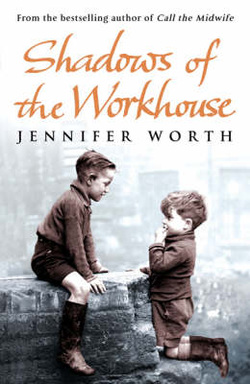
This is the follow up to the very successful and televised Call the Midwife. Like the first, this book is an account of the east end of London during the 1950s as seen by Jennifer Worth, a practicing midwife working with an order of nuns.
I enjoyed reading the first book as it gave a really domestic insight into the time period. Worth tells the lives of the everyday people living in poverty in the east end. She backs up her narratives with useful historical information but it never dominates the stories and the people are always at the forefront.
While the first book focused on the women that Worth helped have children this book follows the lives of those she came into contact in her general nursing capacities. The three main stories are that of Peggy and Frank, siblings who were raised in the workhouse and finally reunited after years apart; Joe a retired soldier who finds comfort in the daily visits from the nurse until he is moved to an old person's home in a renovated workhouse and Sister Monica Joan an eccentric elderly nun with a tendency towards kleptomania.
The stories are really well told and you really feel for the characters but one thing stood out for me as making this book not as good as the first. Because the focus in on fewer people and their stories are told in detail this book reads a lot more like fiction than memoir. I understand that Worth is allowed some level of artistic license but I felt she pushed it a bit at some points and embellished personal details and feelings in a way that made these people seem less real and more like fictional inventions. I felt like these people had already lived lives worth writing about and that these fictional embellishments almost cheapened their experiences and lessened the power of their stories.
That aside, I still really enjoyed the book and the focus on the workhouses was really interesting as I have only ever encountered them whilst studying so the focus was on the politics rather than the people.
I enjoyed reading the first book as it gave a really domestic insight into the time period. Worth tells the lives of the everyday people living in poverty in the east end. She backs up her narratives with useful historical information but it never dominates the stories and the people are always at the forefront.
While the first book focused on the women that Worth helped have children this book follows the lives of those she came into contact in her general nursing capacities. The three main stories are that of Peggy and Frank, siblings who were raised in the workhouse and finally reunited after years apart; Joe a retired soldier who finds comfort in the daily visits from the nurse until he is moved to an old person's home in a renovated workhouse and Sister Monica Joan an eccentric elderly nun with a tendency towards kleptomania.
The stories are really well told and you really feel for the characters but one thing stood out for me as making this book not as good as the first. Because the focus in on fewer people and their stories are told in detail this book reads a lot more like fiction than memoir. I understand that Worth is allowed some level of artistic license but I felt she pushed it a bit at some points and embellished personal details and feelings in a way that made these people seem less real and more like fictional inventions. I felt like these people had already lived lives worth writing about and that these fictional embellishments almost cheapened their experiences and lessened the power of their stories.
That aside, I still really enjoyed the book and the focus on the workhouses was really interesting as I have only ever encountered them whilst studying so the focus was on the politics rather than the people.
 RSS Feed
RSS Feed